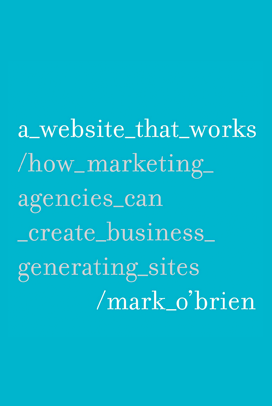Why do you have a website?
This may sound like a foolish question, but it should be the first one you ask when starting every new web project, especially when building your own site. Judging from the many agency sites I see, most principals do not ask themselves this question, or, if they do, they do not seem to take the time to really think about the answer.
Many agencies believe that their site’s central function is to show their visitors how creative they are. I disagree. Certainly, a portion of the site should serve this purpose, but this is not the primary purpose of the site. The site’s key role is to generate business for the firm, and demonstrating creativity is only part of what converts a visitor into a prospect. Designing a website with the primary goal of demonstrating creativity is akin to an architect designing a demo house with the sole intent of showing how many different styles she can design. The result would be an interesting house but not one anyone would ever choose to live in or buy.
The same is true of your website. The site, first and foremost, needs to be a highly usable site. You will not lose a site visitor because the home page is not splashy enough, but you will lose plenty if the site is so “creative” that the visitor cannot figure out how to get to your portfolio section within the first five seconds of landing on the site, for example.
The site is the vehicle that attracts the right prospects to your company. It should intuitively guide them to the pages that interest them the most and entice them to engage with you on a more meaningful level at some point during that first visit. Your site is a tour visitors can take of your firm, but it is a self-guided tour, and visitors will probably not follow the path that you expect.
One indicator that your website is performing well is if visitors can easily learn about the various aspects of your firm as they move through your site based on their interests. The more accurately the site describes your firm’s expertise across different media (imagery, text, video, etc.), and the more intuitive the navigation is between those descriptions, the more successful the site will be. Your portfolio will certainly be part of the tour visitors take, but it is not the only thing they want to know about.
When first approaching your website redesign, it is important to consider your basic strategic plan for the site before jumping into the “real” work of building the site. To help you add some structure to the strategic planning stage of your site, I created a 9 Step Process. This process is designed to help you take a more objective look at why you have a website in the first place. Taking a week or two at the beginning of the web development project to work on your site’s strategy will undoubtedly have a significant and positive effect on the results the site ends up delivering for you. This practice could also extend your site’s shelf-life by a number of years.
Websites take a lot of time, money, and energy to create, and you risk wasting all three of these commodities unless you have a specific plan for the goals of your site. Just winging it and hoping for the best might create a site that represents your firm well enough for the next six to eighteen months, but that approach is unlikely to create a site that has a significant impact on your business over the long term. My goal for you is to create a site that will be an effective revenue-generation tool for your business for three to five years, after which point web design and technology will have probably changed enough to warrant a rebuild.
This post is an excerpt from my book, “A Website That Works.”
#macro:blognav,,23125#

